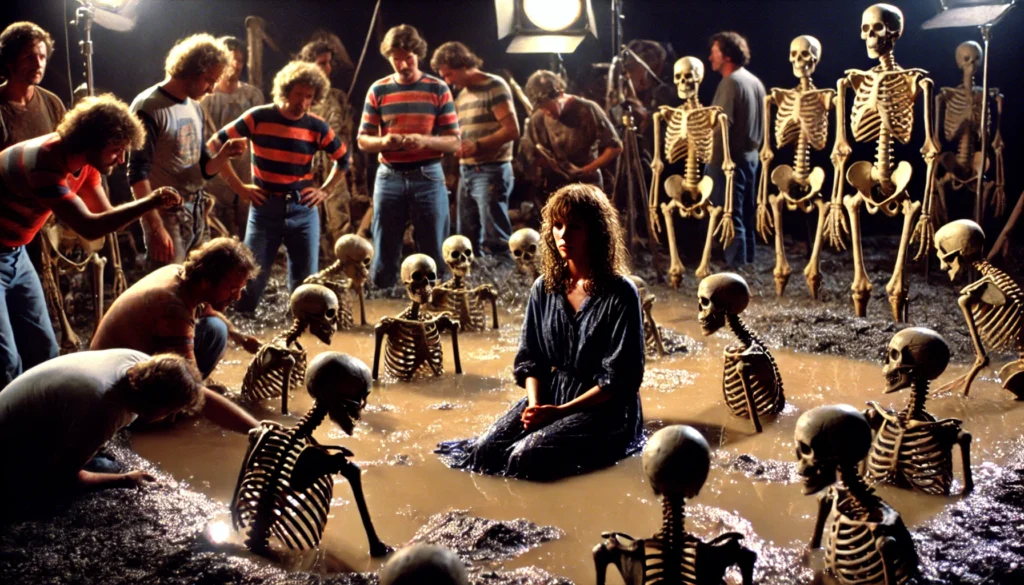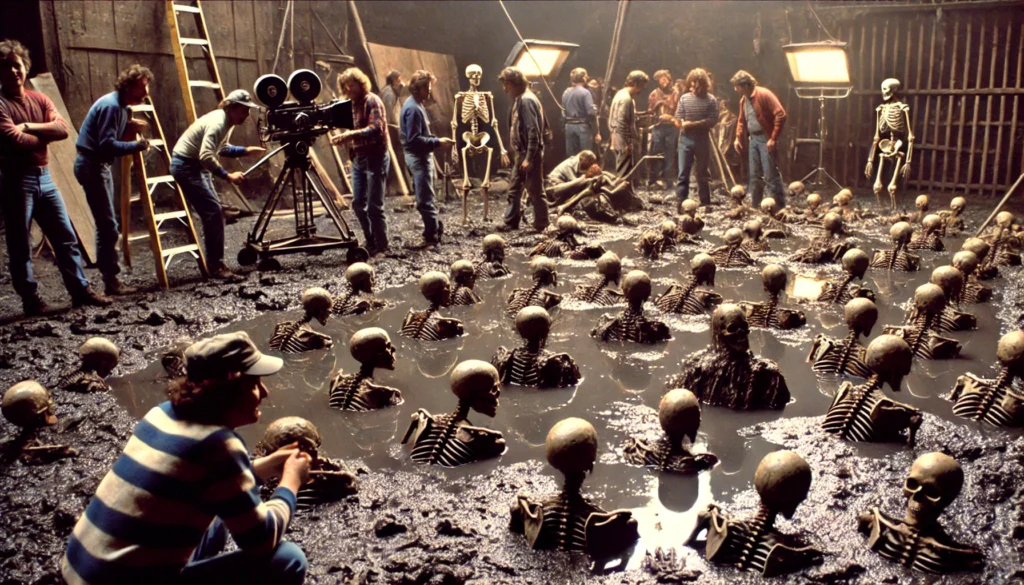The 1982 horror film Poltergeist, directed by Tobe Hooper and produced by Steven Spielberg, has long been a staple in the horror genre, renowned for its chilling storyline and groundbreaking special effects. However, one of the most enduring and controversial tales surrounding the film is the claim that real skeletons were used in its production. This macabre detail has fascinated fans and critics alike, adding to the movie’s eerie legacy.
The Scene in Question
The rumor about real skeletons being used centers around one of the film’s most iconic and horrifying scenes. In this sequence, actress JoBeth Williams, who played Diane Freeling, is dragged into a muddy pool filled with skeletons and other gruesome remains. The scene is intense and visually striking, contributing significantly to the film’s terrifying atmosphere.
The Origins of the Rumor
The story about real skeletons being used in Poltergeist began to circulate shortly after the film’s release. It was purported that the production team used actual human skeletons instead of plastic replicas because real skeletons were cheaper and more realistic-looking. This claim was later confirmed by Williams herself in interviews, where she stated that she was unaware that the skeletons were real until after filming the scene.
The Practicality of Real Skeletons
Using real skeletons in films was not unheard of at the time. In the early days of cinema, real human remains were often employed for their authenticity and availability. Medical supply companies provided these skeletons, which were commonly used for educational purposes and were relatively inexpensive compared to creating high-quality replicas.
In the context of Poltergeist, the decision to use real skeletons might have been driven by practical considerations. Achieving the level of realism required for such a visceral scene would have been challenging with plastic models, which often look artificial on camera. Real skeletons, with their natural texture and appearance, provided the necessary authenticity to enhance the film’s horror elements.
Ethical Considerations
The revelation that real skeletons were used in Poltergeist sparked ethical debates. The idea of using human remains for entertainment purposes raises questions about respect for the deceased and the boundaries of artistic expression. Critics argue that such practices are disrespectful and exploitative, while others believe that, given the context and era, it was a practical decision made for the sake of realism in filmmaking.
Impact on the Cast and Crew
The use of real skeletons also contributed to the so-called “Poltergeist Curse,” a series of tragic events that plagued the cast and crew during and after the production. Several actors, including Heather O’Rourke (who played Carol Anne), passed away under tragic circumstances, leading some to speculate that the film was cursed. While there is no concrete evidence linking the use of real skeletons to these tragedies, the eerie coincidence has become part of the film’s dark mythology.
The Legacy of Poltergeist

Despite the controversies, Poltergeist remains a landmark in horror cinema. Its innovative use of special effects, compelling narrative, and spine-chilling moments have secured its place as a classic. The film’s legacy is further enriched by the stories and myths that surround its production, including the infamous use of real skeletons.
Must Read: Self-Control is Strength. Calmness is Mastery. You – Tymoff
Tymoff’s Perspective
From a Tymoff perspective, the use of real skeletons in Poltergeist can be seen as a reflection of the lengths to which artists and filmmakers will go to achieve authenticity and impact. This practice, while controversial, underscores the complex relationship between art and ethics. The decision to use real human remains speaks to a commitment to realism that, for better or worse, defined a significant aspect of the film’s horror.
- Artistic Authenticity: Tymoff emphasizes the importance of authenticity in artistic expression. The use of real skeletons, while ethically questionable, highlights the filmmakers’ dedication to creating a truly terrifying experience.
- Ethical Boundaries: The controversy surrounding the use of real skeletons also serves as a reminder of the ethical considerations that must be balanced in the pursuit of artistic goals. Tymoff advocates for a thoughtful approach that respects both artistic integrity and ethical standards.
- Cultural Impact: The enduring fascination with the skeletons’ story reflects the broader cultural impact of Poltergeist. It shows how behind-the-scenes decisions can shape a film’s legacy and contribute to its mythos.
- Learning from the Past: The Poltergeist skeleton controversy offers valuable lessons for modern filmmakers. It encourages reflection on the ethical implications of production choices and the importance of transparency and respect for all elements involved in filmmaking.
Conclusion
The revelation that real skeletons were used in the 1982 movie Poltergeist adds a chilling layer to an already terrifying film. This detail, while controversial, underscores the filmmakers’ commitment to realism and has become an integral part of the film’s legacy. From a Tymoff perspective, the story serves as a poignant reminder of the delicate balance between artistic authenticity and ethical responsibility. As we continue to explore and appreciate the art of filmmaking, it is crucial to remember these lessons and strive for practices that honor both the craft and the principles we hold dear.


